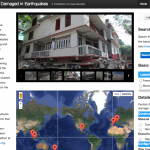Explore the Database
Background
EERI received funding from the U.S. Geological Survey to support the development of a database of photographs from past earthquakes that illustrate deficiencies contributing to collapse of concrete buildings. In addition to photographs, the database is being populated with additional information from particular buildings, including sketches, drawings, and information on retrofit. The ultimate product for the project, due March 2013, is a credible and accessible online database of concrete building performance in past earthquakes. As this database is further populated, it will be able to help analysts understand the relative importance of deficiencies with respect to collapse and performance more generally.
Coordination with ATC 95
Data were collected in coordination with the ATC 95 project, Development of a Collapse Indicator Methodology for Existing Reinforced Concrete Buildings, where experts assembled information on buildings that have collapsed in past earthquakes, primarily in California and New Zealand. While the ATC-95 project focused exclusively on collapsed buildings, the EERI interns and mentors worked with damaged buildings from many countries, including developing countries, the U.S. and New Zealand. Both projects collected data that included detailed information on the building itself, The ATC experts focused on identifying the damage that led to collapse, and the characteristics of the event that caused the damage. EERI interns identified the wide range of building characteristics in such a way that future analysis will be possible. Information was drawn from reports, drawings, photographs, and meetings with mentors and reviewers in an effort to provide insight into the important aspects of the performance of these concrete buildings.
Students and Mentors
Four engineering students were selected as interns for the summer 2012: Sarah Bettinger, University of Alabama, Birmingham; Edwin Lim, Georgia Tech; Quinn Peck, Santa Clara University; and Miguel Robles, Virginia Tech. Their work was coordinated by Maggie Ortiz, EERI program associate and Jonathon Tai, graduate intern. In addition to the students and interns, the project was organized and led by Craig Comartin, Concrete Coalition Technical Director and Marjorie Greene, EERI Special Projects Manager.
An exciting innovation in this project was the interaction of mentors and reviewers from local Bay Area firms as well as several EERI members throughout the world. Mentors met with the interns and discussed particular buildings with them, as well as various reconnaissance observations more generally. In addition, mentors reviewed the individual building reports prepared by the interns. The opportunity for interaction with so many practicing engineers was given by the student interns as one of the highlights of the summer. A list of the mentors and reviewers is provided in the table here.
The Process
The interns worked from an interactive PDF, gathering information from various reports and published articles on the earthquakes, as well as from interviews with the mentors. Each of these reports was then reviewed and revised, based on reviewer comments. An important feature of this form is the list of design and construction characteristics. For each of the 130 characteristics, interns scoured source materials for discussions of the role of the characteristics in the building’s performance. For each characteristic, they indicated its contribution to observed damage as unlikely; possible; likely; unknown (no discussion in the sources), or not applicable (meaning that the particular characteristic was not present or otherwise not relevant for the particular building). The results are presented in the database, available by clicking here.
